Solving the Fornberg–Whitham Model Derived from Gilson–Pickering Equations by Analytical Methods
Abstract
1. Introduction
2. Analysis of the MEFM, the EFM and the MHTM
2.1. The Procedure of EFM
- Step 1: Consider the general nonlinear partial differential equation of the type:
- Step 2: Let:
- Step 3: Rewrite (1) as
- Step 4: Consider the wave solutions as:
- Step 5: To choose the value of p and c, (and similarly d and q), we should balance the linear term of highest (lowest) order of Equation (4) with the highest (lowest) order nonlinear term.
2.2. The Procedure of the MEFM
- Step 1: Assume
- Step 2: Now, let
- Step 3: By dissolving a system of linear equations, we have
2.3. The Procedure of the MHTM
3. Comparing the EFM, the MEFM and the MHTM to Solve Nonlinear PDEs
3.1. Mathematical Analysis of the EFM for the Fornberg–Whitham Model
- Case one ( and ):
- Case two ( and ):
- Case three ( and ):
3.2. Mathematical Analysis of MEFM for a (2+1)-Dimensional Equation
- One wave solutions for (38):
- Two wave solutions for (38):
- Three wave solutions for (38):
3.3. Mathematical Analysis of the MEFM for (61)
- One wave solutions for (61):
- Two wave solutions for (61):
- Three wave solutions for (61):
3.4. Mathematical Analysis of the MHTM for (61)
- One wave solutions for (61):
- Two wave solutions for (61):
- Three wave solutions for (61):
3.5. Discussion
4. Conclusions
Author Contributions
Funding
Data Availability Statement
Conflicts of Interest
References
- Aderyani, S.R.; Saadati, R.; Vahidi, J.; Allahviranloo, T. The exact solutions of the conformable time-fractional modified nonlinear Schrödinger equation by the Trial equation method and modified Trial equation method. Adv. Math. Phys. 2022, 2022, 4318192. [Google Scholar] [CrossRef]
- Aderyani, S.R.; Saadati, R.; Vahidi, J.; Mlaiki, N.; Abdeljawad, T. The exact solutions of conformable time-fractional modified nonlinear Schrödinger equation by Direct algebraic method and Sine-Gordon expansion method. AIMS Math. 2022, 7, 10807–10827. [Google Scholar] [CrossRef]
- Aderyani, S.R.; Saadati, R.; Vahidi, J.; Gómez-Aguilar, J.F. The exact solutions of conformable time-fractional modified nonlinear Schrödinger equation by first integral method and functional variable method. Opt. Quantum Electron. 2022, 54, 218. [Google Scholar] [CrossRef]
- Aderyani, S.R.; Saadati, R.; O’Regan, D.; Inc, M. Soliton Solutions of the Nonlinear Time Fractional Harry Dym Equation in the Caputo Sense and the Symmetric Regularized Long Wave Equation in the Conformable Sense. Res. Sq. 2023. [Google Scholar] [CrossRef]
- Aderyani, S.R.; Saadati, R.; O’Regan, D.; Alshammari, F.S. Describing Water Wave Propagation Using the –Expansion Method. Mathematics 2022, 11, 191. [Google Scholar] [CrossRef]
- Mirzazadeh, M.; Sharif, A.; Hashemi, M.S.; Akgül, A.; El Din, S.M. Optical solitons with an extended (3 + 1)-dimensional nonlinear conformable Schrödinger equation including cubic–quintic nonlinearity. Results Phys. 2023, 49, 106521. [Google Scholar] [CrossRef]
- Chu, Y.M.; Inc, M.; Hashemi, M.S.; Eshaghi, S. Analytical treatment of regularized Prabhakar fractional differential equations by invariant subspaces. Comput. Appl. Math. 2022, 41, 271. [Google Scholar] [CrossRef]
- Malik, S.; Hashemi, M.S.; Kumar, S.; Rezazadeh, H.; Mahmoud, W.; Osman, M.S. Application of new Kudryashov method to various nonlinear partial differential equations. Opt. Quantum Electron. 2023, 55, 8. [Google Scholar] [CrossRef]
- Xie, X.; Wang, T.; Zhang, W. Existence of solutions for the (p, q)-Laplacian equation with nonlocal Choquard reaction. Appl. Math. Lett. 2023, 135, 108418. [Google Scholar] [CrossRef]
- Qin, X.; Liu, Z.; Liu, Y.; Liu, S.; Yang, B.; Yin, L.; Liu, M.; Zheng, W. User OCEAN personality model construction method using a BP neural network. Electronics 2022, 11, 3022. [Google Scholar] [CrossRef]
- Liu, M.; Gu, Q.; Yang, B.; Yin, Z.; Liu, S.; Yin, L.; Zheng, W. Kinematics Model Optimization Algorithm for Six Degrees of Freedom Parallel Platform. Appl. Sci. 2023, 13, 3082. [Google Scholar] [CrossRef]
- Ye, R.; Liu, P.; Shi, K.; Yan, B. State damping control: A novel simple method of rotor UAV with high performance. IEEE Access 2020, 8, 214346–214357. [Google Scholar] [CrossRef]
- Madina, B.; Gumilyov, L.N. Determination of the most effective location of environmental hardenings in concrete cooling tower under far-source seismic using linear spectral dynamic analysis results. J. Res. Sci. Eng. Technol. 2020, 8, 22–24. [Google Scholar] [CrossRef]
- Aslanova, F. A comparative study of the hardness and force analysis methods used in truss optimization with metaheuristic algorithms and under dynamic loading. Journal of Research in Science. Eng. Technol. 2020, 8, 25–33. [Google Scholar] [CrossRef]
- Muhamad, K.A.; Tanriverdi, T.; Mahmud, A.A.; Baskonus, H.M. Interaction Characteristics of the Riemann Wave Propagation in the (2 + 1)-Dimensional Generalized Breaking Soliton System. Int. J. Comput. Math. 2023, 100, 1340–1355. [Google Scholar] [CrossRef]
- He, J.H.; Wu, X.H. Exp-function method for nonlinear wave equations. Chaos Solitons Fractals 2006, 30, 700–708. [Google Scholar] [CrossRef]
- Rezazadeh, H.; Zabihi, A.; Davodi, A.G.; Ansari, R.; Ahmad, H.; Yao, S.W. New optical solitons of double Sine-Gordon equation using exact solutions methods. Results Phys. 2023, 49, 106452. [Google Scholar] [CrossRef]
- Guo, T.; Zaky, M.A.; Hendy, A.S.; Qiu, W. Pointwise error analysis of the BDF3 compact finite difference scheme for viscous Burgers’ equations. Appl. Numer. Math. 2023, 185, 260–277. [Google Scholar] [CrossRef]
- Yiasir Arafat, S.M.; Fatema, K.; Rayhanul Islam, S.M.; Islam, M.E.; Ali Akbar, M.; Osman, M.S. The mathematical and wave profile analysis of the Maccari system in nonlinear physical phenomena. Opt. Quantum Electron. 2023, 55, 136. [Google Scholar] [CrossRef]
- Wang, K. New fractal soliton solutions for the coupled fractional Klein-Gordon equation with β-fractional derivative. Fractals 2023, 31, 2350003. [Google Scholar] [CrossRef]
- Vivas-Cortez, M.; Akram, G.; Sadaf, M.; Arshed, S.; Rehan, K.; Farooq, K. Traveling wave behavior of new (2+1)-dimensional combined KdV–mKdV equation. Results Phys. 2023, 45, 106244. [Google Scholar] [CrossRef]
- Yao, S.W.; Zafar, A.; Urooj, A.; Tariq, B.; Shakeel, M.; Inc, M. Novel solutions to the coupled KdV equations and the coupled system of variant Boussinesq equations. Results Phys. 2023, 45, 106249. [Google Scholar] [CrossRef]
- Shakir, A.P.; Sulaiman, T.A.; Ismael, H.F.; Shah, N.A.; Eldin, S.M. Multiple fusion solutions and other waves behavior to the Broer-Kaup-Kupershmidt system. Alex. Eng. J. 2023, 74, 559–567. [Google Scholar] [CrossRef]
- Cheng, C.D.; Tian, B.; Zhou, T.Y.; Shen, Y. Wronskian solutions and Pfaffianization for a (3+1)-dimensional generalized variable-coefficient Kadomtsev-Petviashvili equation in a fluid or plasma. Phys. Fluids 2023, 35, 037101. [Google Scholar] [CrossRef]
- Shakeel, M.; Shah, N.A.; Chung, J.D. Modified Exp-Function Method to Find Exact Solutions of Microtubules Nonlinear Dynamics Models. Symmetry 2023, 15, 360. [Google Scholar] [CrossRef]
- Shakeel, M.; Alaoui, M.K.; Zidan, A.M.; Shah, N.A. Closed form solutions for the generalized fifth-order KDV equation by using the modified exp-function method. J. Ocean. Eng. Sci. 2022, in press. [Google Scholar] [CrossRef]
- Zulfiqar, A.; Ahmad, J.; Ul-Hassan, Q.M. Analysis of some new wave solutions of fractional order generalized Pochhammer-chree equation using exp-function method. Opt. Quantum Electron. 2022, 54, 735. [Google Scholar] [CrossRef]
- Pan, X.J.; Dai, C.Q. Explicit solutions of a generalized wick-type stochastic Korteveg–de Vries equation. Phys. Scr. 2009, 80, 065006. [Google Scholar] [CrossRef]
- Zhang, S. Exp-function method: Solitary, periodic and rational wave solutions of nonlinear evolution equations. Nonlinear Sci. Lett. A 2010, 2, 143–146. [Google Scholar]
- Ma, W.X.; Huang, T.; Zhang, Y. A multiple exp-function method for nonlinear differential equations and its application. Phys. Scr. 2010, 82, 065003. [Google Scholar] [CrossRef]
- Yajima, N. Application of Hirota’s Method to a Perturbed System. J. Phys. Soc. Jpn. 1982, 51, 1298–1302. [Google Scholar] [CrossRef]
- Gilson, C.; Pickering, A. Factorization and Painlevé analysis of a class of nonlinear third-order partial differential equations. J. Phys. A Math. Gen. 1995, 28, 2871. [Google Scholar] [CrossRef]
- Whitham, G.B. Linear and Nonlinear Waves; John Wiley and Sons: Hoboken, NJ, USA, 2011. [Google Scholar]
- Camassa, R.; Holm, D.D. An integrable shallow water equation with peaked solitons. Phys. Rev. Lett. 1993, 71, 1661. [Google Scholar] [CrossRef]
- Irshad, A.; Mohyud, S.T. Tanh-Coth Method for Nonlinear Differential Equations. Stud. Nonlinear Sci. 2012, 3, 24–48. [Google Scholar]
- Fan, X.; Yang, S.; Zhao, D. Travelling wave solutions for the Gilson-Pickering equation by using the simplified G/G-expansion method. Int. J. Nonlinear Sci. 2009, 8, 368–373. [Google Scholar]
- Chen, A.; Huang, W.; Tang, S. Bifurcations of travelling wave solutions for the Gilson–Pickering equation. Nonlinear Anal. Real World Appl. 2009, 10, 2659–2665. [Google Scholar] [CrossRef]
- Garshasbi, M.; Khakzad, M. The RBF collocation method of lines for the numerical solution of the CH- equation. J. Adv. Res. Dyn. Control Syst. 2015, 4, 65–83. [Google Scholar]
- Zabihi, F.; Saffarian, M. A not-a-knot meshless method with radial basis functions for numerical solutions of Gilson–Pickering equation. Eng. Comput. 2018, 34, 37–44. [Google Scholar] [CrossRef]
- Ali, K.K.; Mehanna, M.S. Traveling wave solutions and numerical solutions of Gilson–Pickering equation. Results Phys. 2021, 28, 104596. [Google Scholar] [CrossRef]
- Bilal, M.; Seadawy, A.R.; Younis, M.; Rizvi, S.T.R.; El-Rashidy, K.; Mahmoud, S.F. Analytical wave structures in plasma physics modelled by Gilson-Pickering equation by two integration norms. Results Phys. 2021, 23, 103959. [Google Scholar] [CrossRef]
- Ali, K.K.; Dutta, H.; Yilmazer, R.; Noeiaghdam, S. On the new wave behaviors of the Gilson-Pickering equation. Front. Phys. 2020, 8, 54. [Google Scholar] [CrossRef]
- Yokuş, A.; Durur, H.; Abro, K.A.; Kaya, D. Role of Gilson–Pickering equation for the different types of soliton solutions: A nonlinear analysis. Eur. Phys. J. Plus 2020, 135, 1–19. [Google Scholar] [CrossRef]
- Rezazadeh, H.; Jhangeer, A.; Tala-Tebue, E.; Hashemi, M.S.; Sharif, S.; Ahmad, H.; Yao, S.W. New wave surfaces and bifurcation of nonlinear periodic waves for Gilson-Pickering equation. Results Phys. 2021, 24, 104192. [Google Scholar] [CrossRef]
- Samir, I.; Badra, N.; Ahmed, H.M.; Arnous, A.H.; Ghanem, A.S. Solitary wave solutions and other solutions for Gilson–Pickering equation by using the modified extended mapping method. Results Phys. 2022, 36, 105427. [Google Scholar] [CrossRef]
- Hu, X.; Jin, Y.; Zhou, K. Optimal System and Group Invariant Solutions of the Whitham-Broer-Kaup System. Adv. Math. Phys. 2019, 2019, 1892481. [Google Scholar] [CrossRef]
- Abouelregal, A.E.; Akgöz, B.; Civalek, Ö. Magneto-thermoelastic interactions in an unbounded orthotropic viscoelastic solid under the Hall current effect by the fourth-order Moore-Gibson-Thompson equation. Comput. Math. Appl. 2023, 141, 102–115. [Google Scholar] [CrossRef]
- Abouelregal, A.E.; Ersoy, H.; Civalek, Ö. Solution of Moore-Gibson-Thompson equation of an unbounded medium with a cylindrical hole. Mathematics 2021, 9, 1536. [Google Scholar] [CrossRef]
- Aderyani, S.R.; Saadati, R.; Vahidi, J. Multiple exp-function method to solve the nonlinear space–time fractional partial differential symmetric regularized long wave (SRLW) equation and the (1 + 1)-dimensional Benjamin–Ono equation. Int. J. Mod. Phys. B 2022, 37, 2350213. [Google Scholar] [CrossRef]
- Aderyani, S.R.; Saadati, R.; O’Regan, D.; Alshammari, F.S. Existence, Uniqueness and Stability Analysis with the Multiple Exp Function Method for NPDEs. Mathematics 2022, 10, 4151. [Google Scholar] [CrossRef]
- Lai, S.; Luo, K. Wave breaking to a shallow water wave equation involving the Fornberg-Whitham model. J. Differ. Equ. 2023, 344, 509–521. [Google Scholar] [CrossRef]
- Boutarfa, B.; Akgül, A.; Inc, M. New approach for the Fornberg–Whitham type equations. J. Comput. Appl. Math. 2017, 312, 13–26. [Google Scholar] [CrossRef]
- Yu, Z.; Shi, X.; Qiu, X.; Zhou, J.; Chen, X.; Gou, Y. Optimization of postblast ore boundary determination using a novel sine cosine algorithm-based random forest technique and Monte Carlo simulation. Eng. Optim. 2021, 53, 1467–1482. [Google Scholar] [CrossRef]
- Polyanin, A.D.; Zaitsev, V.F. Handbook of Nonlinear Partial Differential Equations; Chapman and Hall/CRC: Boca Raton, FL, USA, 2016. [Google Scholar]
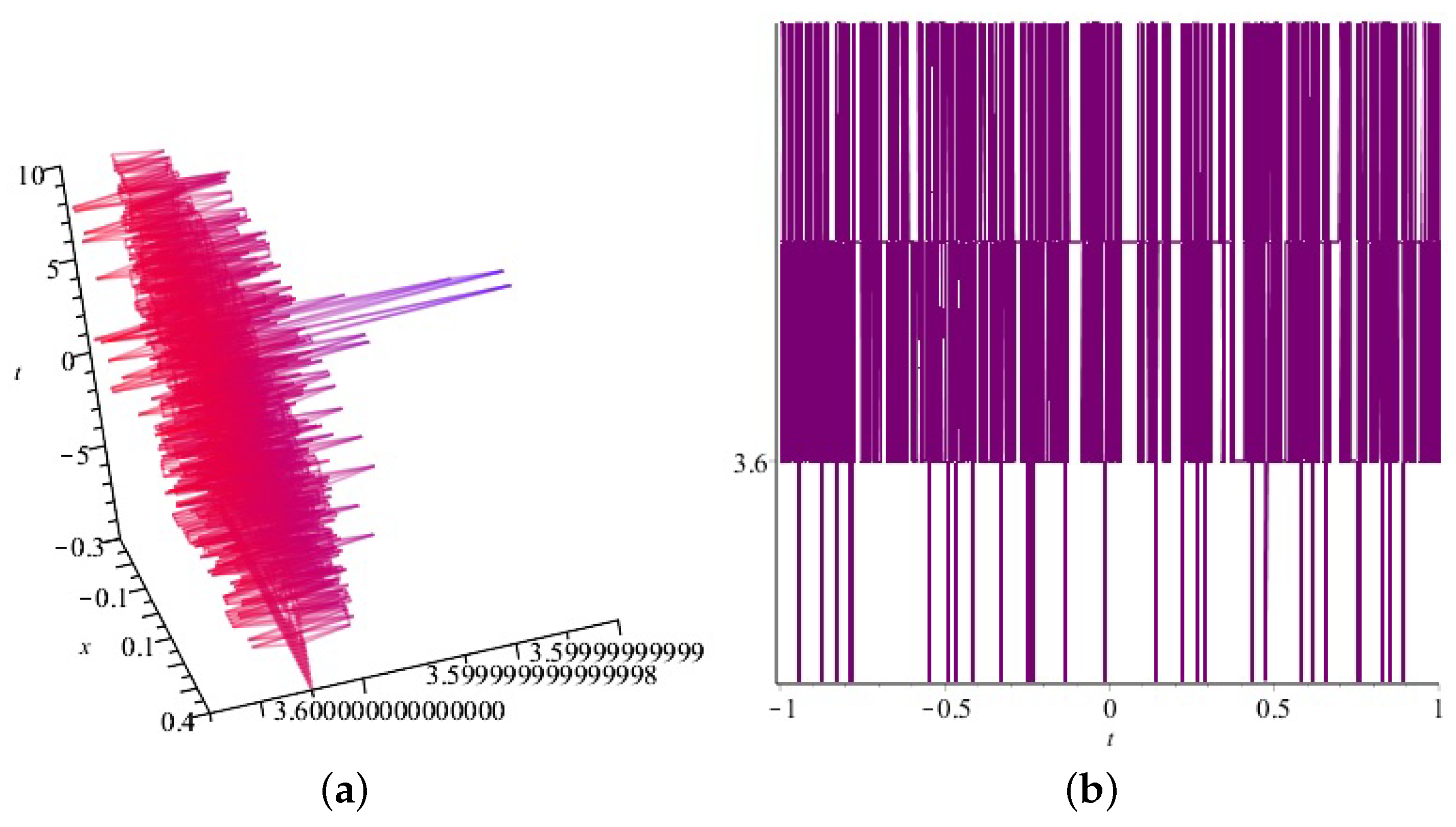
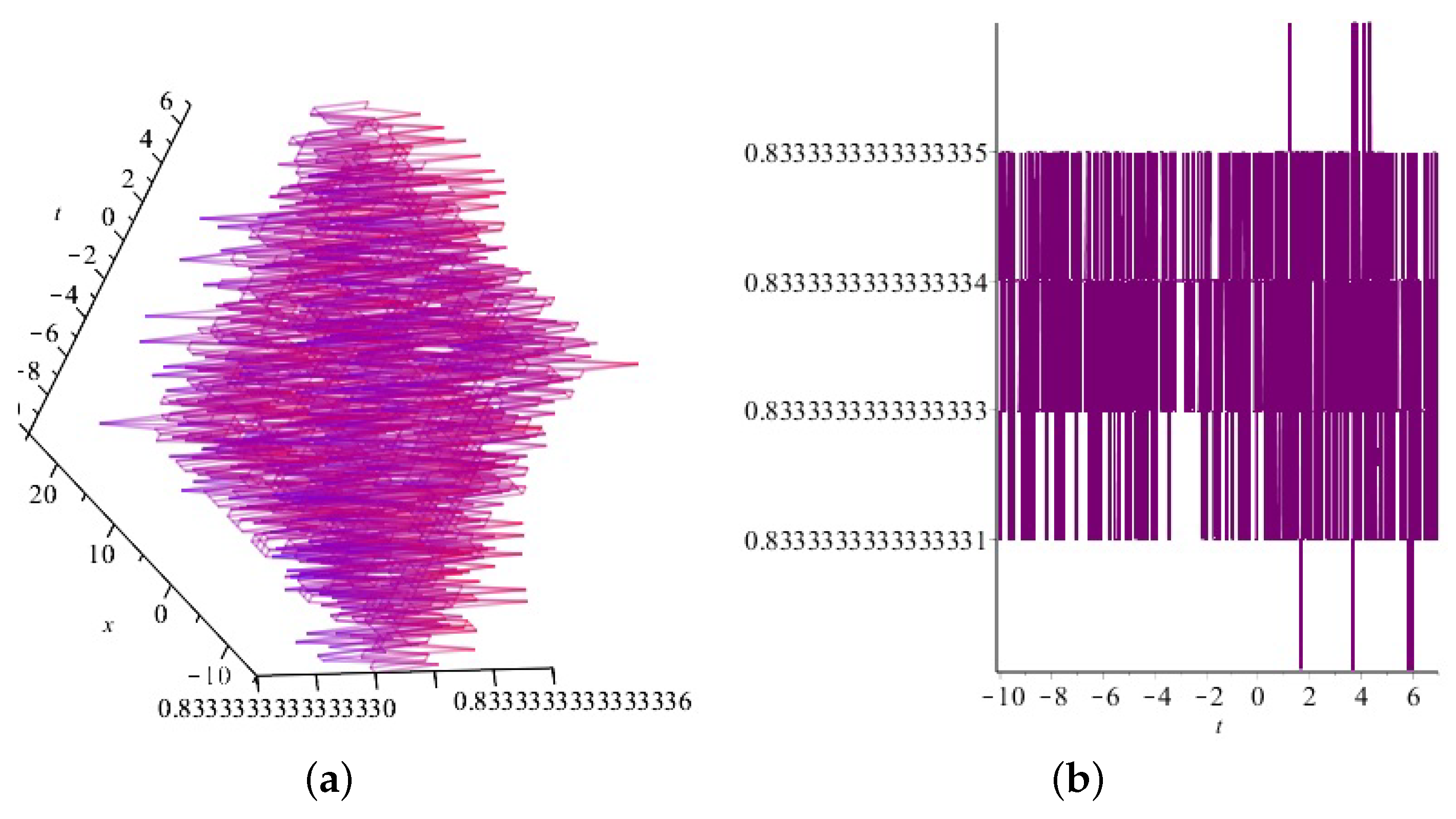
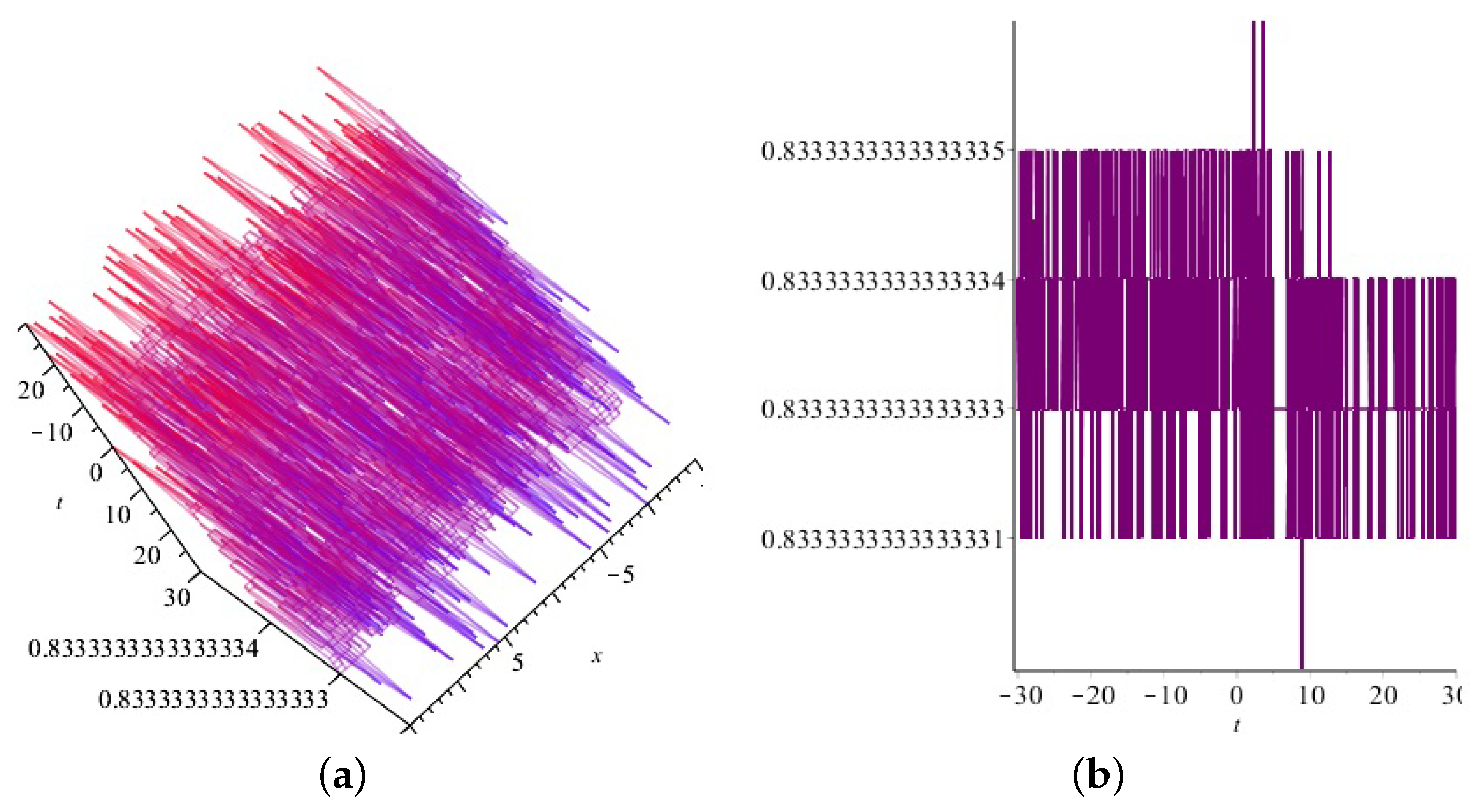






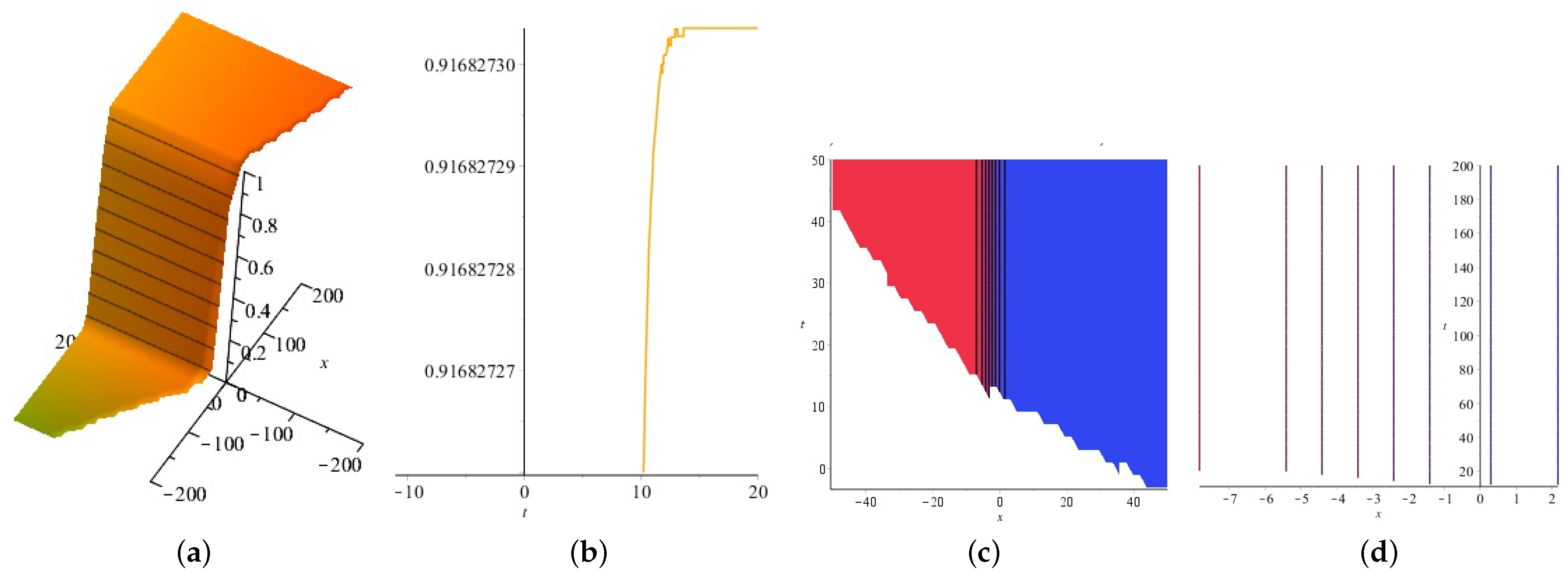





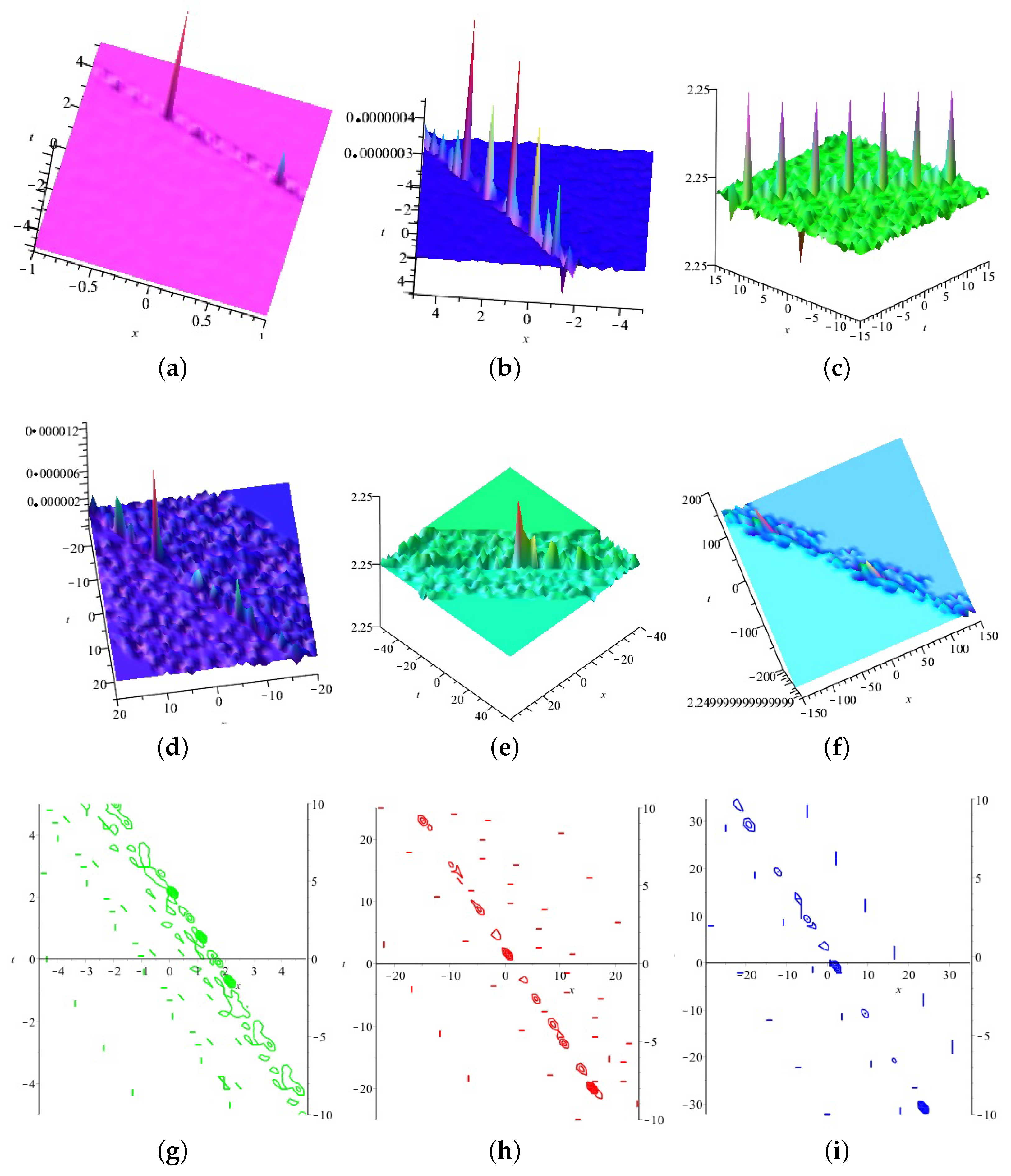
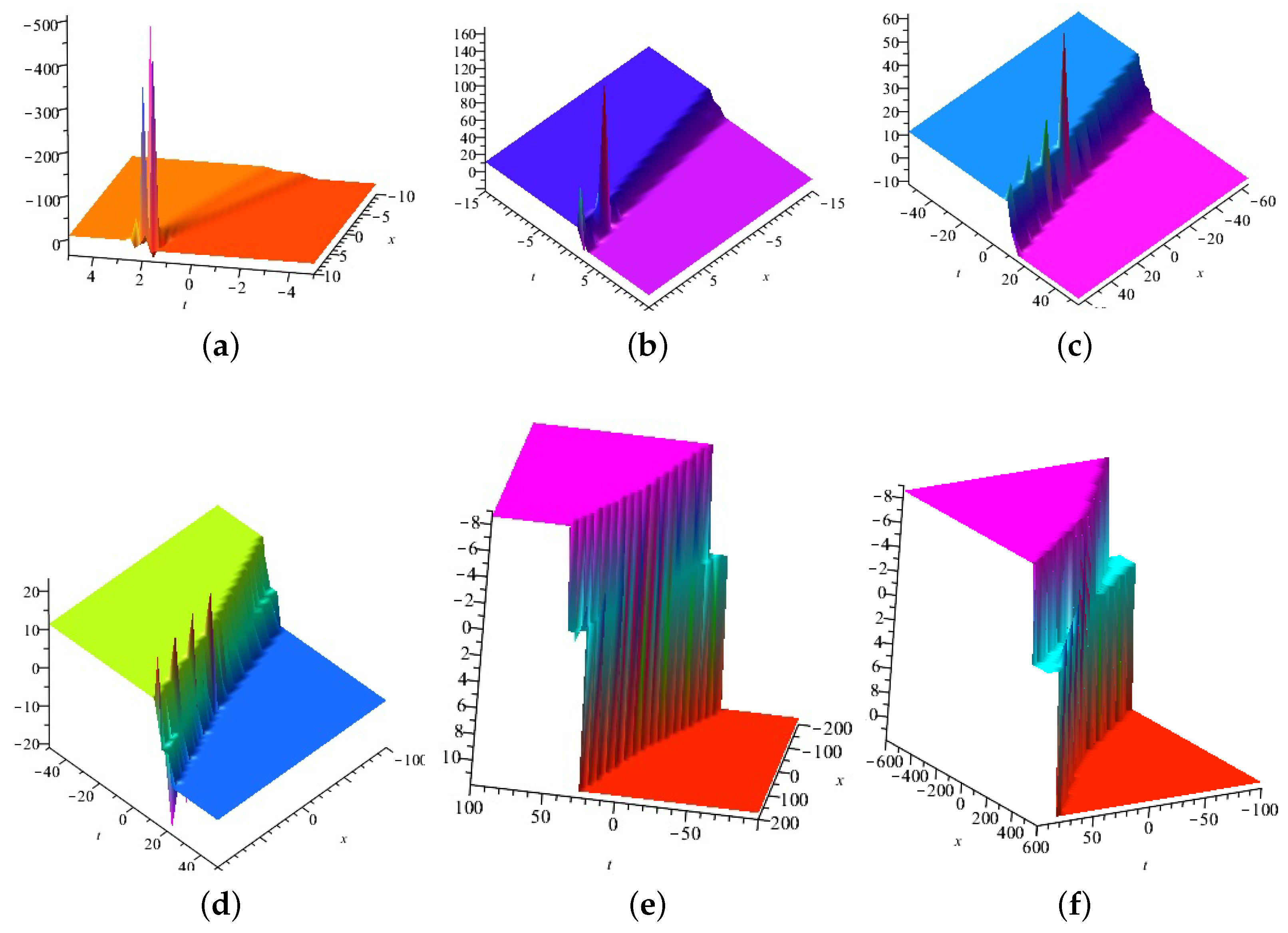
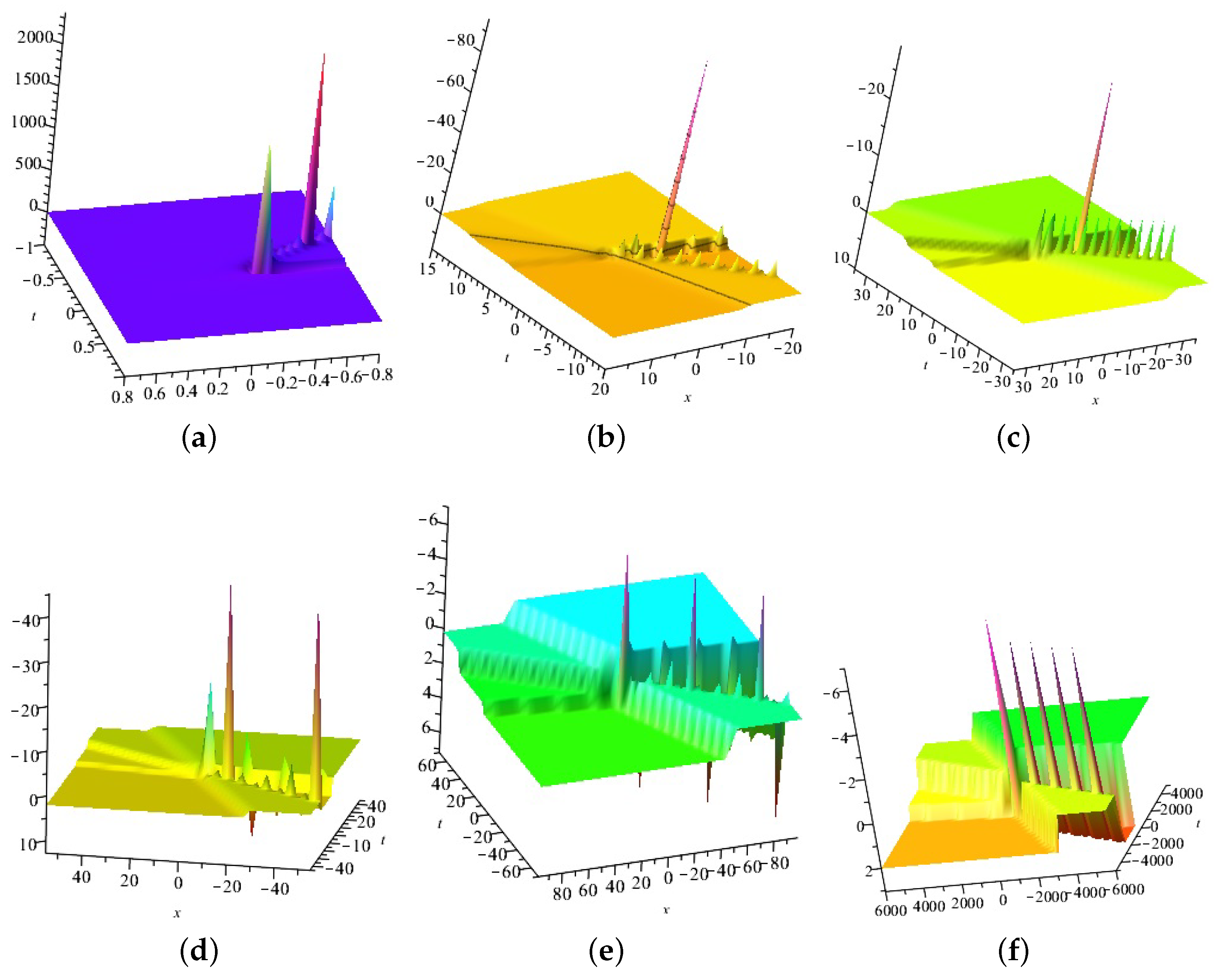
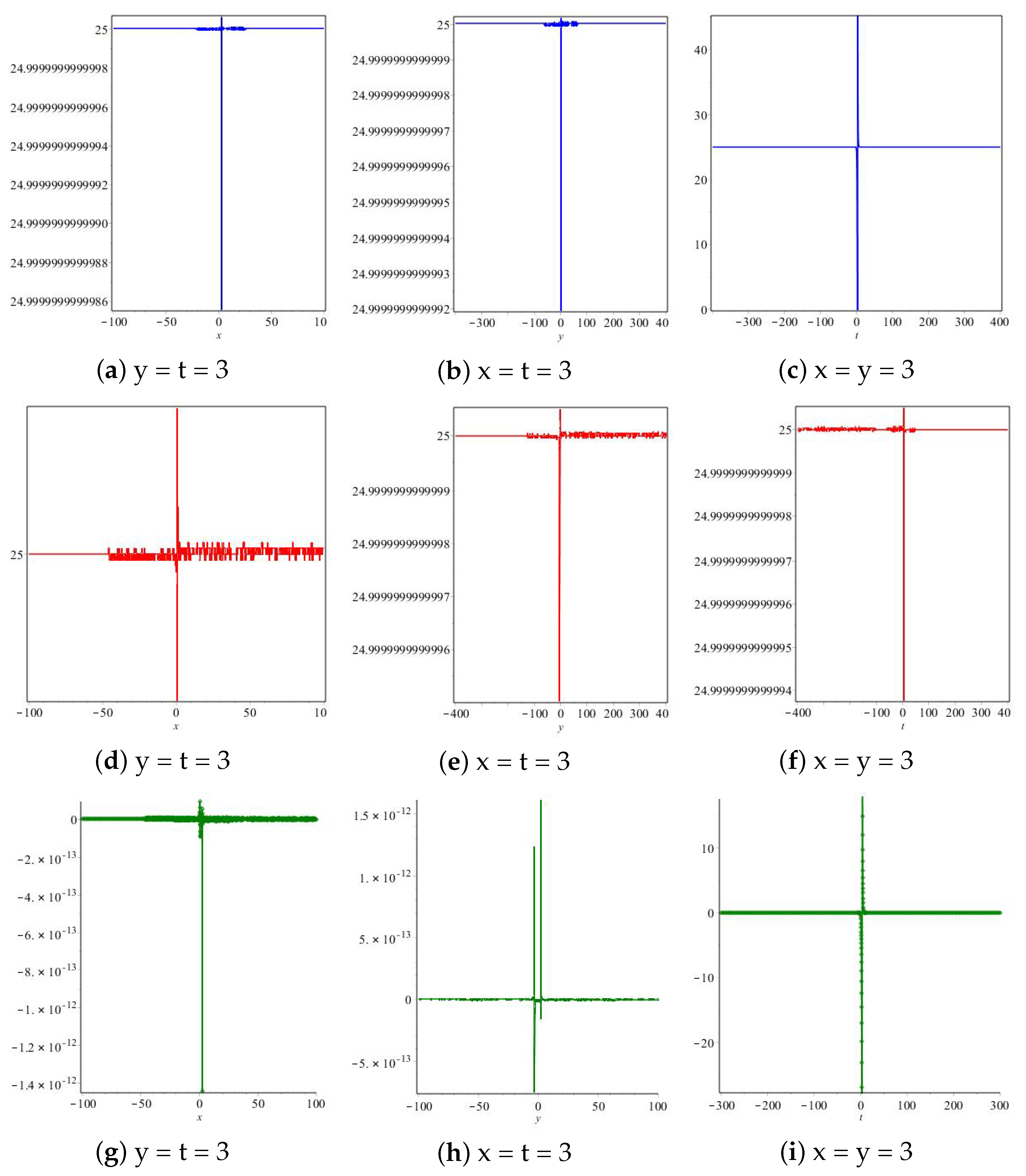
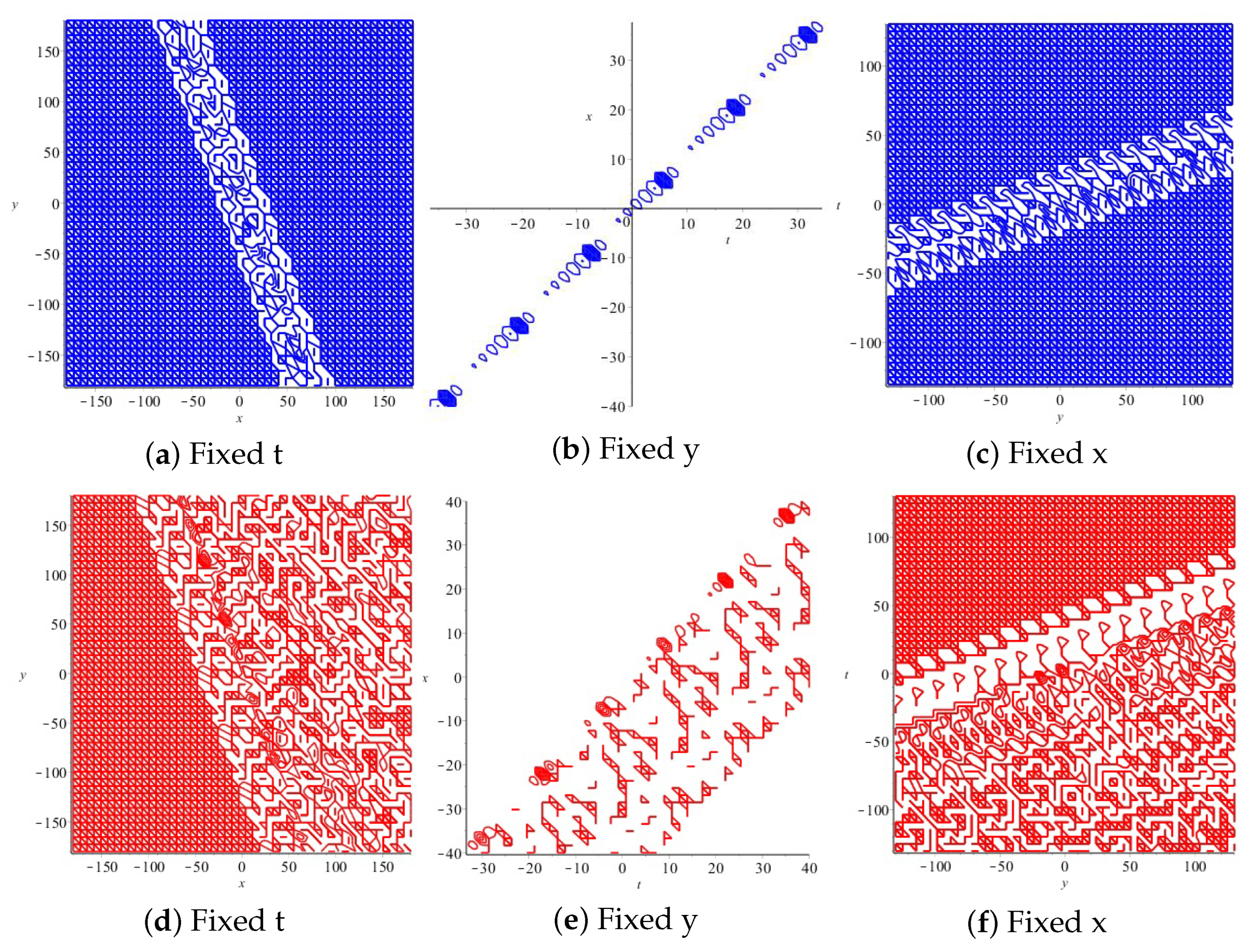
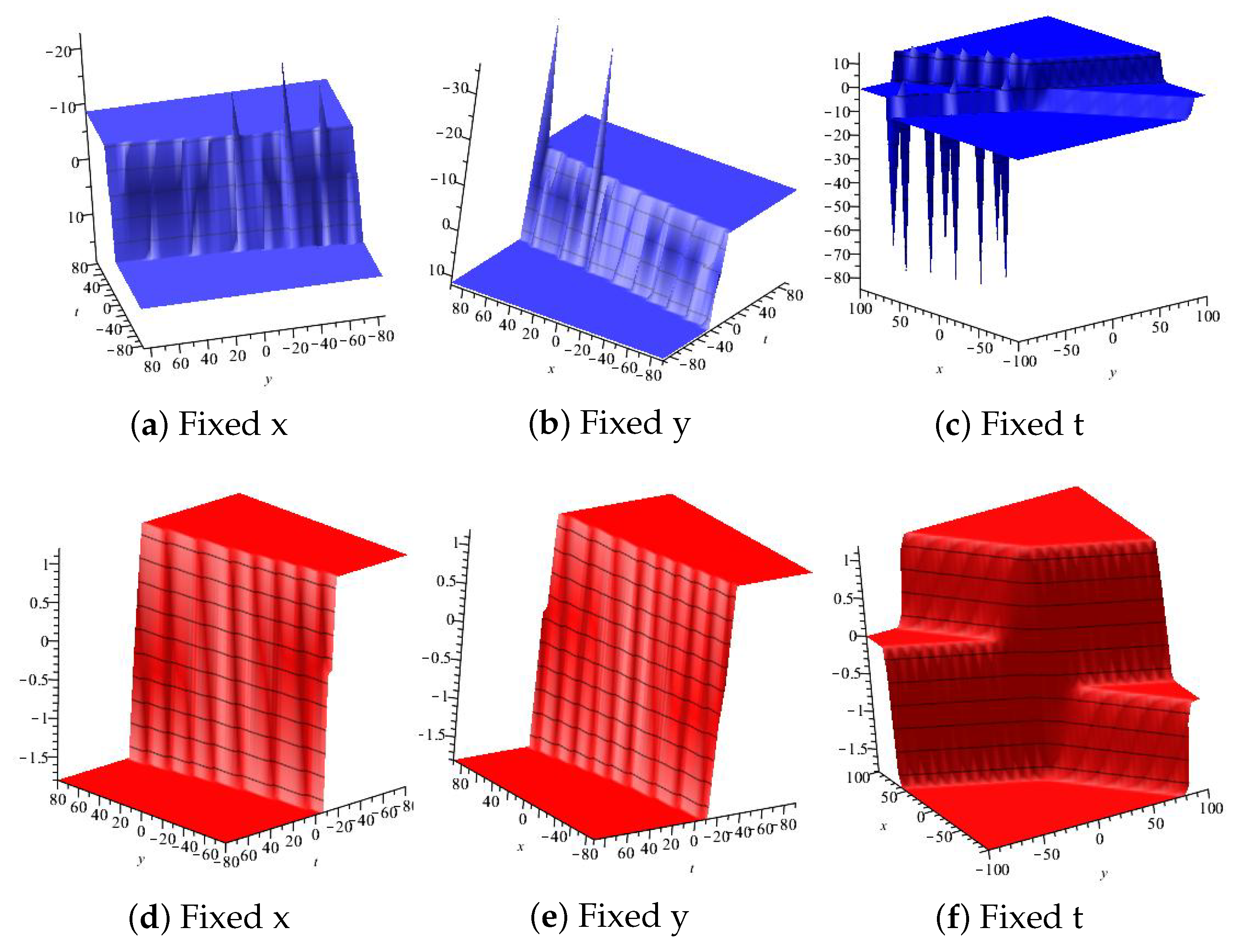
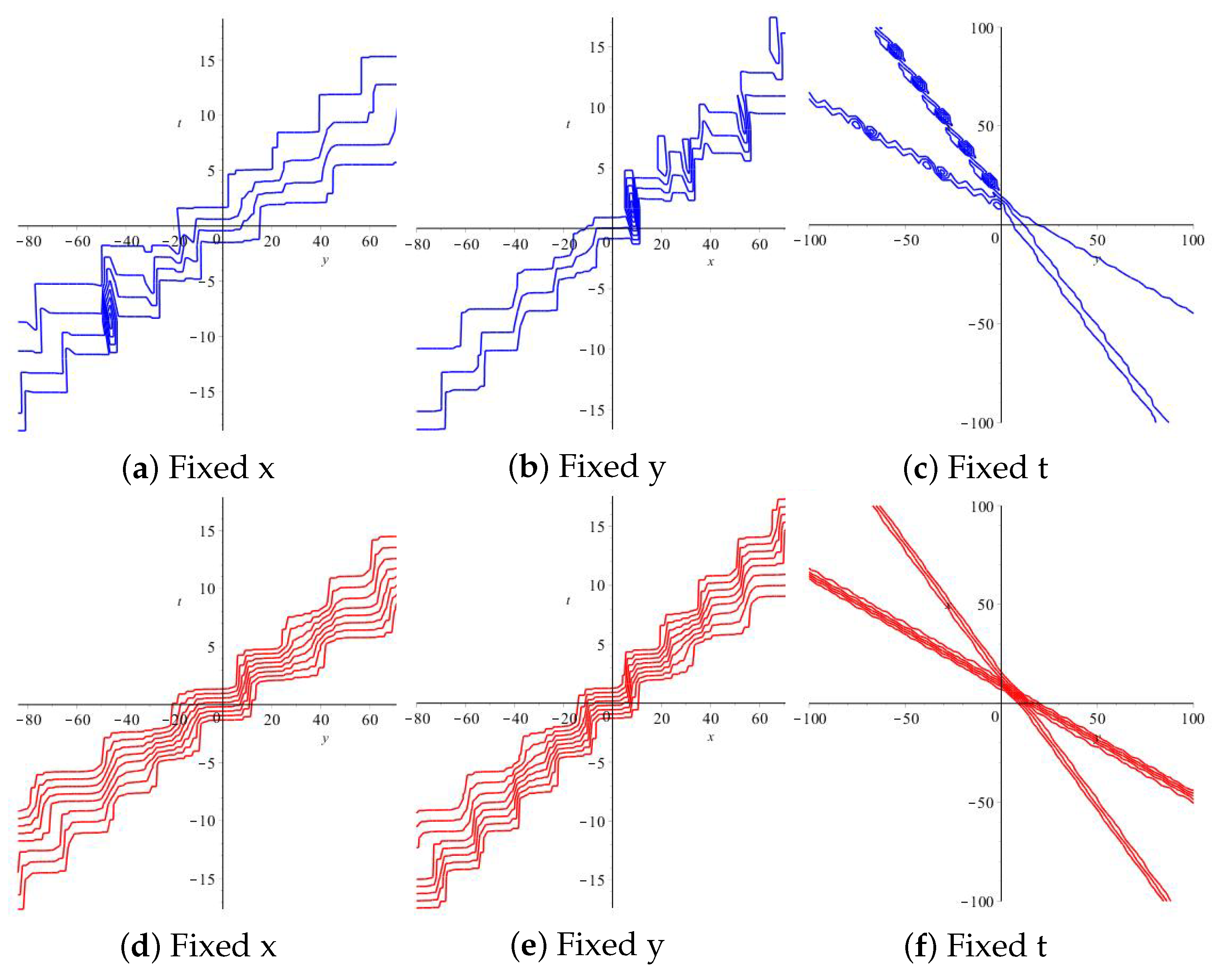
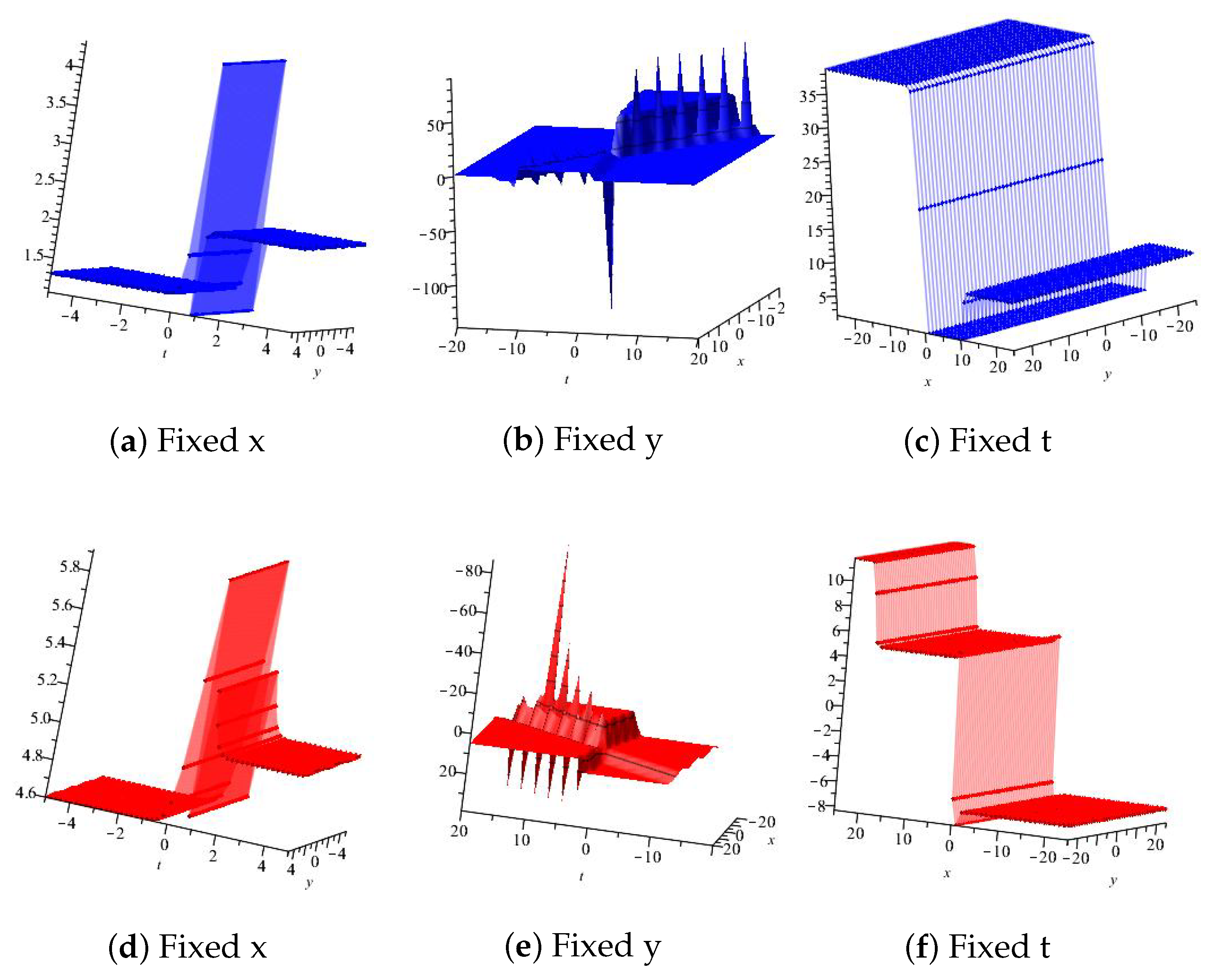
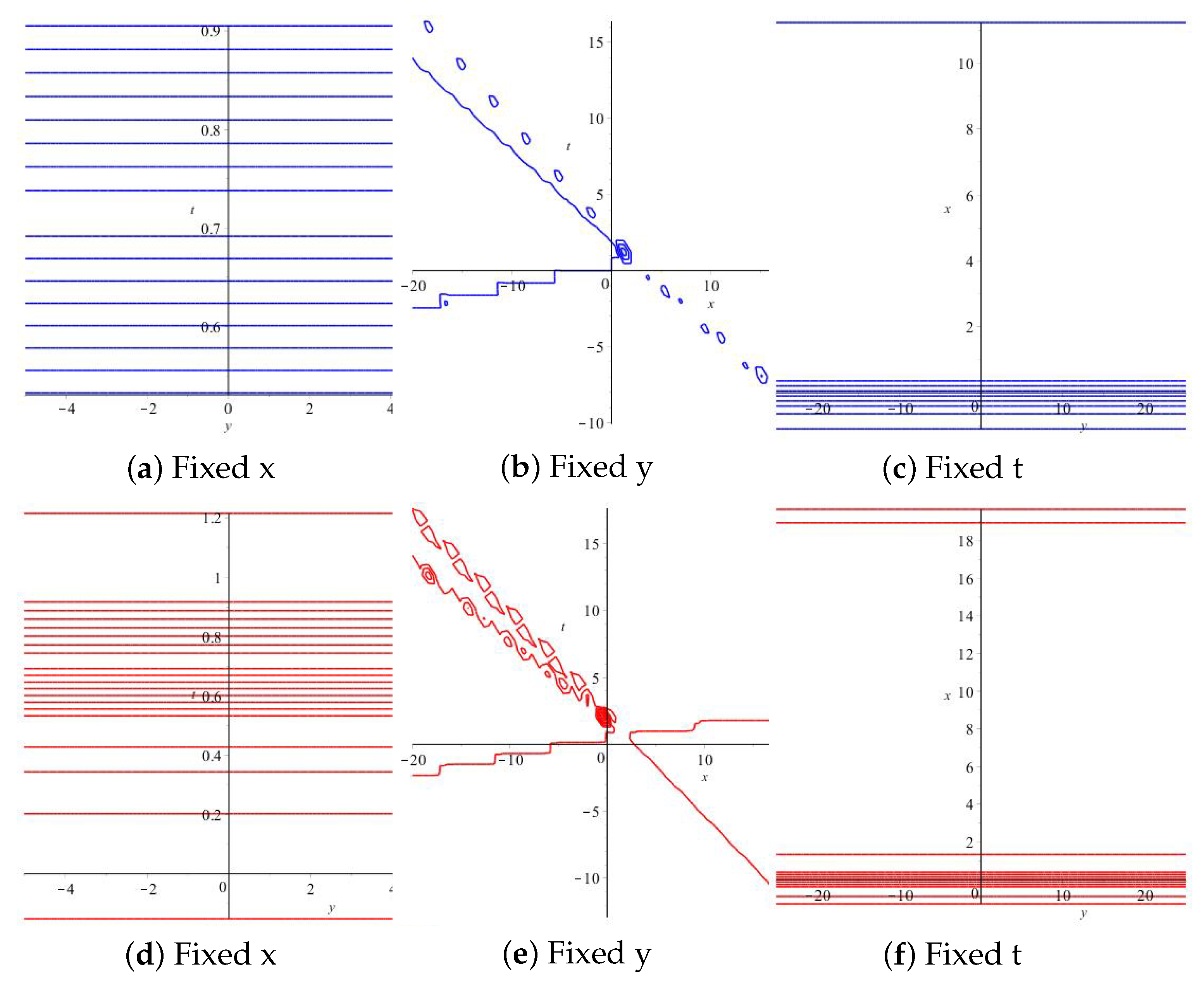
| One-Wave Solution | Two-Wave Solution | Three-Wave Solution | |||||
|---|---|---|---|---|---|---|---|
| = 0.20 | x | ||||||
| 0.20 | 24.99999999 | 25.00000000 | 0.17538519 | 0.94952115 | 0.18226002 | 0.02165664 | |
| 0.30 | 25.00000002 | 25.00000000 | 0.17726173 | 0.87076905 | 0.18434795 | 0.03003873 | |
| 0.40 | 25.00000001 | 25.00000001 | 0.17914924 | 0.79998766 | 0.18645254 | 0.03870608 | |
| 0.50 | 25.00000000 | 24.99999999 | 0.18104754 | 0.73604704 | 0.18857376 | 0.04767017 | |
| 0.60 | 24.99999999 | 25.00000000 | 0.18104754 | 0.67802134 | 0.19071154 | 0.05694300 | |
| 0.70 | 24.99999999 | 25.00000000 | 0.18487583 | 0.62514465 | 0.19286584 | 0.06653706 | |
| 0.80 | 25.00000001 | 25.00000001 | 0.18690543 | 0.57677795 | 0.19503658 | 0.07646545 | |
| 0.90 | 25.00000000 | 25.00000000 | 0.18874510 | 0.53238384 | 0.19722370 | 0.08674179 | |
| One-Wave Solution | Two-Waves Olution | Three-Wave Solution | |||||
|---|---|---|---|---|---|---|---|
| = 0.20 | x | ||||||
| 0.20–0.30 | 0.00000001 | 0.00000000 | 0.00187654 | 0.07875210 | 0.00208793 | 0.00838209 | |
| 0.30–0.40 | 0.00000001 | 0.00000001 | 0.00188751 | 0.07078139 | 0.00210459 | 0.00866735 | |
| 0.40–0.50 | 0.00000001 | 0.00000002 | 0.00180983 | 0.06394062 | 0.00212122 | 0.00896409 | |
| 0.50–0.60 | 0.00000001 | 0.00000001 | 0.00000000 | 0.05802570 | 0.00213778 | 0.00927283 | |
| 0.60–0.70 | 0.00000000 | 0.00000000 | 0.003382829 | 0.05287669 | 0.00215430 | 0.00959406 | |
| 0.70–0.80 | 0.00000001 | 0.00000001 | 0.00202960 | 0.04836670 | 0.00217074 | 0.00992839 | |
| 0.80–0.90 | 0.00000001 | 0.00000000 | 0.00183967 | 0.04439411 | 0.00218712 | 0.01027634 | |
Disclaimer/Publisher’s Note: The statements, opinions and data contained in all publications are solely those of the individual author(s) and contributor(s) and not of MDPI and/or the editor(s). MDPI and/or the editor(s) disclaim responsibility for any injury to people or property resulting from any ideas, methods, instructions or products referred to in the content. |
© 2024 by the authors. Licensee MDPI, Basel, Switzerland. This article is an open access article distributed under the terms and conditions of the Creative Commons Attribution (CC BY) license (https://creativecommons.org/licenses/by/4.0/).
Share and Cite
O’Regan, D.; Aderyani, S.R.; Saadati, R.; Allahviranloo, T. Solving the Fornberg–Whitham Model Derived from Gilson–Pickering Equations by Analytical Methods. Axioms 2024, 13, 74. https://doi.org/10.3390/axioms13020074
O’Regan D, Aderyani SR, Saadati R, Allahviranloo T. Solving the Fornberg–Whitham Model Derived from Gilson–Pickering Equations by Analytical Methods. Axioms. 2024; 13(2):74. https://doi.org/10.3390/axioms13020074
Chicago/Turabian StyleO’Regan, Donal, Safoura Rezaei Aderyani, Reza Saadati, and Tofigh Allahviranloo. 2024. "Solving the Fornberg–Whitham Model Derived from Gilson–Pickering Equations by Analytical Methods" Axioms 13, no. 2: 74. https://doi.org/10.3390/axioms13020074
APA StyleO’Regan, D., Aderyani, S. R., Saadati, R., & Allahviranloo, T. (2024). Solving the Fornberg–Whitham Model Derived from Gilson–Pickering Equations by Analytical Methods. Axioms, 13(2), 74. https://doi.org/10.3390/axioms13020074










